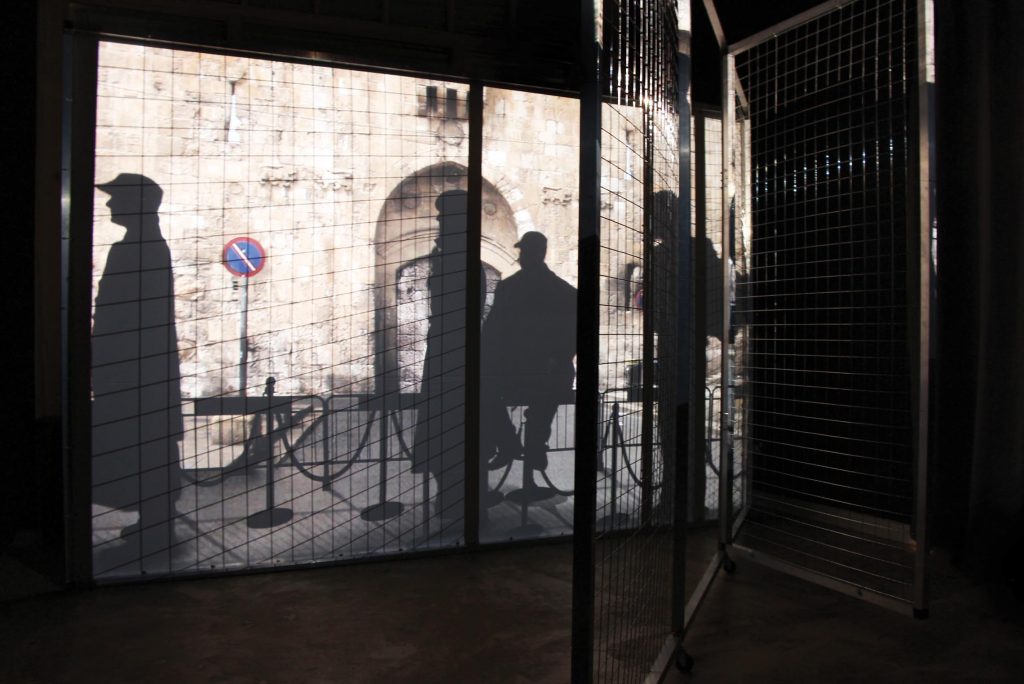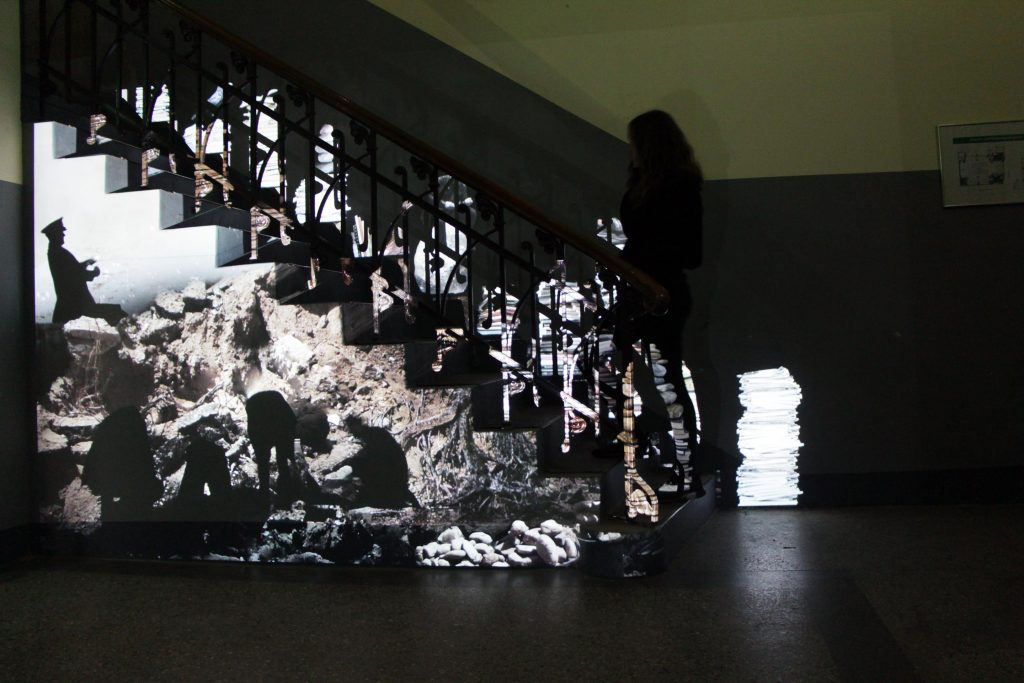The Performance-Based Video Works of Sharon Paz
Ines Lindner
In her work, Sharon Paz explores power relations and their consequences. They can be coagulated as an architecture or a landscape, or can become palpable in small scenes. The actors themselves remain invisible; only their shadows emerge before the filmed backdrop. Figures and actions are typified. Their choreography is superimposed onto the video image.
Usually, the silhouettes are part of the video work projected in the exhibition space. Sometimes they are generated by a live performance: the actors perform in the space between the projector and the projection surface. The exhibition visitors can inspect this intermediate space. It thus becomes clear that the shadows do not precisely overlap with the image. The bodies of the actors interrupt the projection beam. Usually in a projection the bundled light passes through a space kept free of disturbance in order to transfer the visual information. In Paz, this apparently neutral space between the image and the reproduction of the image is actively occupied. Here, the space between image and projection that is blocked out in standard forms of image perception becomes a space of action. The beholder can also pass through this intermediate space and his or her shadow—intentionally or unintentionally—can become part of the work for a moment.

As complex as Paz’s works might be in terms of structure, they are equally clear in their appearance. In the one-channel installation Open | Close (2014), the shadows of gates and fences close back and forth, squeaking and grinding. Shadow figures rush back and forth, wait or lash out at one another. The original black gradually lightens and a door becomes visible. The work seems to be a generally human parable on the blocked access and the unrest and aggression that it can trigger. The gate is not just any gate, but Jerusalem’s Lions Gate, which leads into the Old City in the Muslim Quarter.
Paz was born in Israel and lives in Berlin. Her works refer frequently to concrete political relations. They deal with Israeli policy and German history, with trauma, memory, and forgetting. The scenes that Paz develops for her works are condensations that both intensify experience and keep their distance from concrete events.
This is also true of her use of sound. It always has a clear reference to the event being alluded to, but is a bit more complicated than a sound that merely accompanies the images. It seems typified. In a similar way, she uses the abstract impact of shadow. The reduction awakens our imaginative powers. We immediately begin to interpret the figures. It is rather like when we make shadows of bunnies on the wall with two fingers stretched out from our fist. The space between hand and shadow becomes a space of transformation in which the given is reduced and can be transformed to the imagined.
According to the myth of the emergence of the art of drawing, a woman is said to have captured the outlines of her lover before he went off to war.[1] This legend combines the shadow with absence, death, and longing as the beginning of the art of drawing and providing a sign. On the one hand rudimentary, on the other fantastic. Both have accompanied the shadow play in various cultures. Silhouettes are used for the Javanese theater of gods and heroes. In the salons of the 18th century, producing silhouettes was a popular pastime. In her art, Kara Walker has recourse to silhouettes in American folk art for her panoramas of slave history. William Kentridge uses them in his recent video works to narrate the oppression of blacks in South Africa. The link between black silhouettes and the representation of oppression and racism has a hint of self-evidence to it. In the works of both artists, the black figures stand out from a bright, neutral backdrop. This corresponds to the tradition of the silhouette. Paz, in contrast, uses video images. She creates a media layering that sets the stylized shadows in tension with the depiction of concrete locations.
In the work We Forgot (2015), the spectators can look into the space in which the shadows are created and can follow the actions of the performers. In a live performance, the status of the media projection changes. It stops appearing as a simulated present. The video images are past, dream, and imagination. The performance, however, takes place here and now.
The classic form of combining projection and live performance can still be found today at Prague’s Laterna Magika.2 The variety-show effect consists in calibrating the body movements of the actors perfectly to match the space of illusion of the film and both fuse in the perception of the spectators. But the entertainment factor lies in the fact that the spectator never forgets that the apparent naturalness of impression results from the often near-acrobatic efforts of the actors to synchronize their movement with the projected images. Sometimes, Paz plays with the congruency of projection and performance, but usually it is about the difference.
The performance projection We Forgot includes the spectator. A group is given instructions that a second group, which has been watching, then repeats. It is the same and yet not the same. As in retelling a tale, the repetition brings the action up to date. The action, its repetition, and the memory of the action are never brought into sync. The play with difference allows for a creative space of perception and composition, but at the same time is also the source of doubt and conflict. Was it this way? Or different? Who decides this? What consequences result from the difference?
In Paz’s works, it is often about the reflective distance, a space of thought and imagination that helps to change the view of conflict situations. When Paz superimposes the shadow play of two fighting individuals in wheelchairs onto ruins (Paralyzed Movement, 2014), the entire absurdity of the violent conflict is made visible. In another work she takes up the difficult subject of exile in a simple and poetic way (The Right to Leave, 2013). Through the windows of passing rail cars, we can see Israeli landscapes and views of the Black Forest. The schematic outlines of the rail cars can be traced back to the silhouette of the Raumerweiterungshalle, or literally “space expansion hall,” a foldable and easily transportable pavilion that was developed in East Germany to provide extra room whenever needed. Another sequence of the work is about the lack of room. In the game Musical Chairs there is always one chair fewer than the number of participants in the game. They run around the line of empty chairs while the music plays. Whenever it suddenly stops, each player tries to sit on a chair. One player will always remain standing and is then excluded from the game. Researchers attribute the German name of the game, Reise nach Jerusalem, or “Journey to Jerusalem,” to the fact that room on the journey to the Promised Land was always limited. In Paz’s work, it could also allude to the dramatic conditions of those driven into exile by German Fascism. The title The Right to Leave is perhaps a reference to the fact that Israelis are now taking advantage of their right to take the reverse route and withdraw from their national “duty” to remain. Finding a place here can depend on the moment in history in question. In developing her works the artist refers repeatedly to the relationships in both countries. No Walls (2013) reflects on the German division and was on view at Bernauer Strasse subway station.

Paz presented the two-channel installation Blindspots (2016) at KulturRaum in the Zwingli-Kirche, located in Berlin-Friedrichshain. One of the projections filled the side wall of an ascending stairwell and showed silhouettes of figures digging in the soil. The upper part of the projection was thrown onto the wall behind it. It was beamed step by step onto the rear wall of the stairwell, as if things were placed there. Those who went up or down the stairs became part of the work with their shadow and walked through the scenes of digging. Was a tunnel being dug out? Was this an act of excavation or perhaps burial? The ambivalence is characteristic for the poetic and parable-like aspect of Paz’s works, which often have a tendency towards the absurd. Alongside the stair projection there is a second, smaller projection that beams a hole in the wall just over the floor. Very frequently, Paz’s video images lead across a threshold to a different place. Windows, doors, holes, and tunnels set limits and open passages. The usually dark framing outlines them and emphasizes the transition from one realm to the next. Not everything is visible. The framing concentrates the gaze, stimulating our curiosity to see what remains hidden to us.
When the stairs are climbed upstairs, such a site of transition is revealed. Those who looked carefully could discover that the second video showed the very corridor into which one could look. The miniaturized repetition showed simply what could be seen above, and yet it seemed different, more secret.
Paz also directs our attention at the space between the
image and the reproduction of the image when she is not using a choreography of
shadows. And yet, the movement of shadows makes the otherwise neutral space
available to experience as a space of action. In that the actors interrupt the
projection beam with their bodies, it becomes a space of transformation. On the
projection surface, this interruption seems like a media layering. Film image
and shadow play are related to each other. But because they belong to two
different levels of representation, they remain separate for the beholder. The
difference opens a space that refers to the real space between image and
projection, which can be used for reflections and interventions.
[1] Pliny the Elder, The Natural History, Book XXXV, Chap. 43.2 Alfréd Radok developed the first program as the Czechoslovak contribution to Expo 1958 in Brussels.